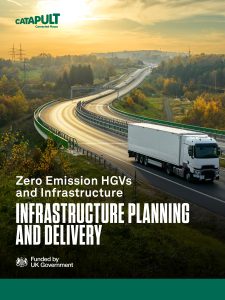Zero Emission HGVs Safety and Security
File type: pdf
File size: 57.77Mb

Heavy Goods Vehicles (HGVs) are vital to industry and represent the backbone of trade and commerce worldwide. They are responsible for ensuring we have access to food, medicines, and goods of all kinds.
Almost 90% of domestic goods transported in the UK in 2022 were moved by road – the vast majority of which by HGVs. These vehicles currently produce approximately 19% of all UK domestic transport greenhouse gas emissions. By 2050, this must be reduced to zero, in line with the UK Government’s Net Zero Strategy.
Connected Places Catapult is supporting Innovate UK and the Department for Transport with the Zero-Emission HGV & Infrastructure Demonstrator programme, which represents a public investment of up to £200 million, match-funded by industry. The programme is deploying the first large (40+ tonne) zero-emission HGVs in significant numbers, together with supporting infrastructure, which will enable freight operators to determine the suitability of the new technology for their operations. Public-facing battery-electric charging stations and hydrogen refuelling stations will enable HGVs to go beyond ‘back to base’ operations.
Together with the British Standards Institution (BSI), Connected Places Catapult is supporting partners involved in the Innovate UK-funded demonstrations, and stakeholders in the wider zero-emission HGV ecosystem.
Learn more in our new reports:

Zero Emission HGVs Safety and Security
File type: pdf
File size: 57.77Mb

Zero Emission HGVs and Infrastructure: Infrastructure Planning and Delivery
File type: pdf
File size: 94.64Mb
In the coming weeks, we will publish the remaining reports, including:
To be notified as soon as these reports are available, please complete this form.
Standards are crucial in ensuring zero-emission HGVs can roll out in an efficient and safe manner, with interoperability embedded from the start, and to create a market that delivers on required outcomes. Through the standards work, in partnership with BSI, we have formed a Standards Advisory Group for zero-emission road freight that will provide the decision making and governance for the standards development work. Three ‘flex’ standards, which are well suited to fast-moving areas of innovation, are currently being developed.
Further to the publication of the Zero Emission HGVs and Infrastructure Standards Prioritization Report, we’re pleased to announce that the following standards have been released as part of our project:
BSI Flex 2071 offers recommendations on how to design charging sites for battery electric HGVs, including safety considerations and optimal layouts.
Specification for operating workshops, inspection, and maintenance of battery electric and hydrogen-fuelled heavy-duty vehicles.
Design recommendations and implementation of mobile and static hydrogen refuelling sites – Code of practice.
Further background on our standards work can be viewed here.
If you’d like to find out more, please email us at zeroemissionroadfreight@cp.catapult.org.uk.
Complete this form to be notified when new reports are available.

